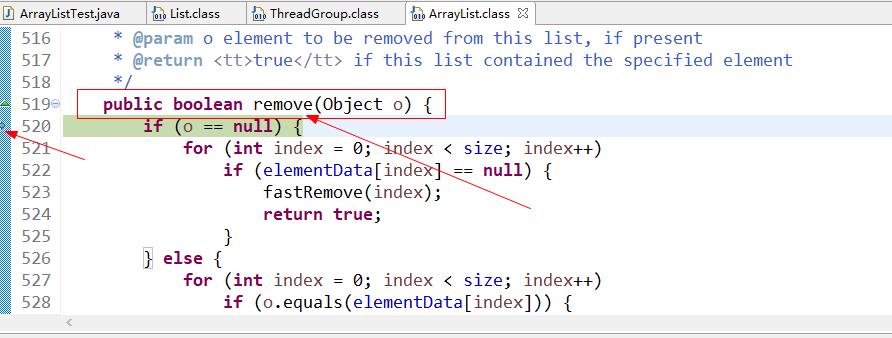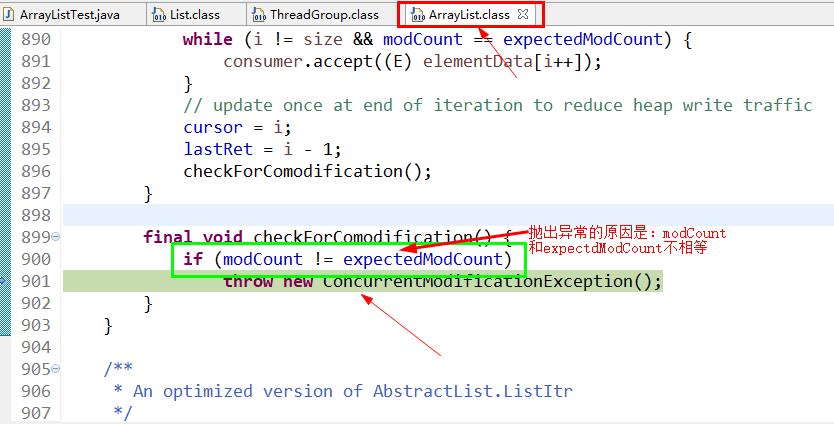一直听别人讲,对ArrayList,通过for循环和foreach循环来remove集合中的元素,前者不会报错,后者会报错,但是一直没有尝试,今天正好上午在深入Collection学习,就自己尝试验证一下。
一、代码实例
要求:
在循环中,移除ArrayList中的元素
代码实例1:
public static void main(String[] args) {
//创建list代码
List<String> list1 = new ArrayList<String>();
list1.add("张振华");
list1.add("王振华");
list1.add("李振华");
list1.add("赵振华");
list1.add("刘振华");
list1.add("何振华");
list1.add("高振华");
System.out.println(list1);
//通过for循环来删除(和foreach二选一)
for(int i=0;i<list1.size();i++){
if("张振华".equals(list1.get(i))){
list1.remove(i);
}
}
System.out.println(list1);
}
实例代码2:
public static void main(String[] args) {
//创建list代码
List<String> list1 = new ArrayList<String>();
list1.add("张振华");
list1.add("王振华");
list1.add("李振华");
list1.add("赵振华");
list1.add("刘振华");
list1.add("何振华");
list1.add("高振华");
System.out.println(list1);
//通过for循环来删除(和foreach二选一)
Integer i;
for(i=0;i<list1.size();i++){
if("张振华".equals(list1.get(i))){
list1.remove(i);
}
}
System.out.println(list1);
}
代码实例3:
public static void main(String[] args) {
//创建list代码
List<String> list1 = new ArrayList<String>();
list1.add("张振华");
list1.add("王振华");
list1.add("李振华");
list1.add("赵振华");
list1.add("刘振华");
list1.add("何振华");
list1.add("高振华");
System.out.println(list1);
//通过foreach循环来删除(对比上述的for循环)
for (String temp : list1) {
if ("张振华".equals(temp)) {
list1.remove(temp);
}
}
System.out.println(list1);
}
由此可见,在分别执行了3种情况的循环移除ArrayList集合元素的例子后,使用for循环,可以成功移除掉集合中的元素,但是实例2没有删掉;使用foreach,直接报错。
二、分析
1.“实例代码2”为什么没有remove掉集合元素?
针对“实例代码2”,为什么没有成功的移除掉ArrayList中的元素,参考ArrayList源码中的remove方法:
public E remove(int index) { //传入的index值为int类型
rangeCheck(index);
checkForComodification();
E result = parent.remove(parentOffset + index);
this.modCount = parent.modCount;
this.size--;
return result;
}
public void remove() {
if (lastRet < 0)
throw new IllegalStateException();
checkForComodification();
try {
ArrayList.this.remove(lastRet);
cursor = lastRet;
lastRet = -1;
expectedModCount = modCount;
} catch (IndexOutOfBoundsException ex) {
throw new ConcurrentModificationException();
}
}
private void rangeCheck(int index) {
if (index < 0 || index >= this.size)
throw new IndexOutOfBoundsException(outOfBoundsMsg(index));
}
java本身认为你传的参数是一个Object(Integer确实不是基本类型,属于Object对象),于是跳到了remove的重载方法,找到了这个尴尬的原因。
2.“实例代码3”使用foreach()为什么直接报错?
在跟代码的过程中,步入发现底层在这里抛出了异常:
(图1.1)
而且抛出的这个异常checkForComodification()就是在ArrayList源码中的“Itr”这个内部类当中,Itr如下:
/**
* An optimized version of AbstractList.Itr
*/
private class Itr implements Iterator<E> {
int cursor; // index of next element to return --用于返回下一个元素的索引
int lastRet = -1; // index of last element returned; -1 if no such -- 返回最后一个元素的索引
int expectedModCount = modCount;
public boolean hasNext() {
return cursor != size;
}
@SuppressWarnings("unchecked")
public E next() {
checkForComodification();
int i = cursor;
if (i >= size)
throw new NoSuchElementException();
Object[] elementData = ArrayList.this.elementData;
if (i >= elementData.length)
throw new ConcurrentModificationException();
cursor = i + 1;
return (E) elementData[lastRet = i];
}
public void remove() {
if (lastRet < 0)
throw new IllegalStateException();
checkForComodification();
try {
ArrayList.this.remove(lastRet);
cursor = lastRet;
lastRet = -1;
expectedModCount = modCount;
} catch (IndexOutOfBoundsException ex) {
throw new ConcurrentModificationException();
}
}
@Override
@SuppressWarnings("unchecked")
public void forEachRemaining(Consumer<? super E> consumer) {
Objects.requireNonNull(consumer);
final int size = ArrayList.this.size;
int i = cursor;
if (i >= size) {
return;
}
final Object[] elementData = ArrayList.this.elementData;
if (i >= elementData.length) {
throw new ConcurrentModificationException();
}
while (i != size && modCount == expectedModCount) {
consumer.accept((E) elementData[i++]);
}
// update once at end of iteration to reduce heap write traffic
cursor = i;
lastRet = i - 1;
checkForComodification();
}
final void checkForComodification() {
if (modCount != expectedModCount) //上述代码报错的地方
throw new ConcurrentModificationException();
}
}之后,演示跳进remove之后的执行套路:
1.进入remove方法
/**
* Removes the first occurrence of the specified element from this list,
* if it is present. If the list does not contain the element, it is
* unchanged. More formally, removes the element with the lowest index
* <tt>i</tt> such that
* <tt>(o==null ? get(i)==null : o.equals(get(i)))</tt>
* (if such an element exists). Returns <tt>true</tt> if this list
* contained the specified element (or equivalently, if this list
* changed as a result of the call).
*
* @param o element to be removed from this list, if present
* @return <tt>true</tt> if this list contained the specified element
*/
public boolean remove(Object o) {
if (o == null) {
for (int index = 0; index < size; index++)
if (elementData[index] == null) {
fastRemove(index);
return true;
}
} else {
for (int index = 0; index < size; index++)
if (o.equals(elementData[index])) {
fastRemove(index);
return true;
}
}
return false;
}2.当传入的object和elementData[index]匹配之后,进行fastRemove(index)方法:
/*
* Private remove method that skips bounds checking and does not
* return the value removed.
*/
private void fastRemove(int index) {
modCount++;
int numMoved = size - index - 1;
if (numMoved > 0)
System.arraycopy(elementData, index+1, elementData, index,
numMoved);
elementData[--size] = null; // clear to let GC do its work
}追踪到在fastRemove()方法中,有一个全局变量modCount;而且在图1.1所示的报错信息中,也是因为modCount和expectMod值不同所引起来的,这就是报异常所在的原因!!
反思:expectedModCount和modCount究竟是什么???
(1)modCount
在jdk1.8中,因为ArrayList继承自AbstractList:
public class ArrayList<E> extends AbstractList<E>/**
* The number of times this list has been <i>structurally modified</i>.
* Structural modifications are those that change the size of the
* list, or otherwise perturb it in such a fashion that iterations in
* progress may yield incorrect results.
*/
protected transient int modCount = 0;private class Itr implements Iterator<E> {
int cursor; // index of next element to return
int lastRet = -1; // index of last element returned; -1 if no such
int expectedModCount = modCountmodCount;当程序执行到上述的fastRemove()中时:
private void fastRemove(int index) {
modCount++;
int numMoved = size - index - 1;
if (numMoved > 0)
System.arraycopy(elementData, index+1, elementData, index,
numMoved);
elementData[--size] = null; // clear to let GC do its work
}然而继续跟踪代码,之后回跳到内部类Itr的checkForComodification()方法中,此时会比较:
final void checkForComodification() {
if (modCount != expectedModCount)
throw new ConcurrentModificationException();
}也就是说,如果使用foreach循环的时候,切记不能再其中remove集合元素,因为使用foreach遍历,本身会在ArrayList内部创建一个迭代器iterator,同时还有一个变量modCount,这两个值在每次遍历元素时会比较,而在执行remove方法之后,进入fastremove,就把modCount给修改了,之后就崩掉了。。。。。。
所以,这就分析出了为什么在foreach中不要移除元素。
That's all.
























 5420
5420

 被折叠的 条评论
为什么被折叠?
被折叠的 条评论
为什么被折叠?








